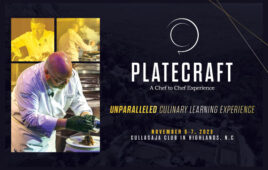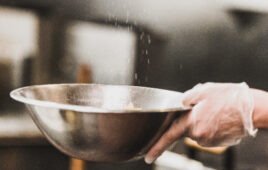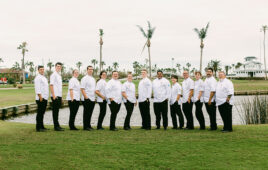 |
 |
| Dining takes center stage at The Anglers Club in Key Largo, Fla. (top) and is also an important contributor to the overall experience at The Bald Peak Colony Club (bottom) on the shoreline of Lake Winnipesaukee, near Melvin Village, N.H. |
 |
| Ed Bigwood, in full “Florida mode” |
Chef Robert E. (Ed) Bigwood has a more diverse calendar book than most of us—he experiences all that we do as club chefs, but at two separate properties.
Ed spends his summers in New Hampshire at The Bald Peak Colony Club, nestled into the shoreline of Lake Winnipesaukee, near Melvin Village. Bald Peak Colony, which opened in 1921, is a Donald Ross design and one of New England’s treasures of golf. Golf is king at Bald Peak, and the chef understands this. He also knows that his membership, which comes to vacation in New Hampshire from some of the most affluent communities of the U.S., has a refined palate and expects quality.
Then, from November through April, Chef Ed is responsible for operations at The Anglers Club in Key Largo, Fla. Started as a trading post and fishing camp at the turn of the twentieth century, the club is located on the bay side of Card Sound, next door to The Ocean Reef Resort. And at this property, dining clearly takes center stage.
Even while leading this “dual life,” Chef Ed found time to talk with us and provide some “singular” lessons for all club chefs, drawn from his two very unique positions:
Q: Ed, how does running F&B at two very different types of clubs affect how you go about your business?
A: In both cases, the memberships have very refined palates and know exactly what they want. We always have to remember that they spend half the year in other parts of the country, where they experience some fantastic dining.
Bald Peak being a country club, the main focus is understandably on the course. However, the food and beverage operations generate a large amount of the club’s revenues, and so we are still under the spotlight on a regular basis.
In Key Largo, the emphasis is on the dining experience and the club is very traditional, both in its setting and the general membership’s attitude. If anything, I find it more challenging to meet the high expectations of the Anglers Club members. We are immediately next door to the Ocean Reef Property, and with so many dining venues to choose from, I have to be on my toes.
Q: Both properties are a bit off the beaten track; how do you get quality products to your door?
A: While it’s true that both clubs are not in major metropolitan areas, that’s not necessarily a bad thing. Reduced noise, traffic, human congestion are a good tradeoff to pay for some limitations on deliveries.
The Internet, too, has made this all a lot easier. It’s now one of the most useful tools that a chef can have, and makes it easier to source product than ever before.
I do believe in “from farm to table” and in using as many locally grown and produced items as possible. And it does seem to me there are a lot more artisan farmers—be they cheese makers, ice cream makers, bakeries, organic farmers, or beef, lamb, pork or bison growers—in the Northeast than in Florida. At the same time, I certainly have my pick of local produce stands in south Florida.
A: nother thing I’ve had to get used to in Florida is “Keys time.” There is absolutely no such thing as a sense of urgency in that part of the country. If you need something done “now,” that means it might get done this month, or maybe not. It is such a laid-back community, it seems even the tides are slower than elsewhere.
Q: What types of menu items or programs have you tried to integrate from one club to the other?
A: A couple of years ago, I introduced a prime beef program in New Hampshire and it went over very, very well. We started what we call Chop Night, where we put cuts out in the dining room for people to see and to choose from. We cut all the meat to order and to the members’ size requirements, then send it back to the kitchen to be prepared. This became quite a popular evening. And, again, to use all of the local resources available, I try to pair the entrée items with locally produced products.
I have also started a prime program at Key Largo. It hasn’t taken off the way it has in New Hampshire, but with the abundance, variety and availability of seafood here in Florida, I can take the same concept and translate it to buying seafood as freshly as possible and running as varied a menu as members’ tastes will allow. So at Key Largo, each station on the line also has a nightly creation, using specialty products we have purchased in small quantities.
Q: You have often mentioned the “hands-on” and positive nature of the relationships you have with your respective house committees. Can you offer some pointers to those of us who may not be as fortunate, and would like to enjoy the same kind of constructive relationships?
A: At both clubs, our house committees are made up of frequent users of the facilities who are in for lunch or dinner almost every day. So I interact with them on a regular basis. Sometimes, I find that by having casual conversations with these members, I get more information than I would in a more formal setting.
I listen to what they have to say, take their comments back to my team, and try to find ways to implement their ideas. Even if I may not initially believe they will work, I have been surprised on more than one occasion.
Relationships with the house committee chairs are even more critical. At both of my clubs, the people in these positions are extremely knowledgeable about food, how it is prepared and how it should be served. They travel all the time and bring back ideas from the places they have been. They dine in places I would trade my favorite knife for the opportunity to try. They know what they want, and it’s my job to give it to them. In the end, this is their club and it should be about what they want, not what I as the chef want to give them. C&RB
Q: Chef, it’s a credit to your talent as a manager that so much of your culinary team travels with you to both properties. Can you tell us how you have developed such a cohesive unit, and about some of the challenges you face when hiring seasonal staff?
A: I have been very lucky in hiring some wonderfully talented people over the years who are hard-working and loyal. Several members of my team travel with me from club to club, which certainly makes the transition easier.
Seasonal staff is not a challenge to be taken lightly. During the winter months, I spend a week traveling with my general manager from our club in New Hampshire across Florida to recruit needed staff. Over the years, we have built up some great relationships wit
h other seasonal clubs and resorts in Florida. I rely heavily on chefs at these properties to steer me in the right direction when it comes to interviewing those who have applied for F&B positions in the area. We also run ads in the major newspapers from Miami to Vero Beach and from Naples to Tampa.
We have a very intensive interviewing process, and let all potential candidates know upfront that we require drug testing. For those we hire, we provide housing at both clubs—it is free in Key Largo, and we only charge a nominal fee in New Hampshire. We also provide free uniforms and meals, as well as free cable in New Hampshire.
Q: I know you’ve said that 65 percent of your entrée sales at Key Largo is yellowtail snapper. What do you do to enhance it and keep it interesting?
A: The recipes we use for the yellowtail have been here a long, long time—and we follow them faithfully! The members know how they want their fish prepared, and don’t want any experimenting with this particular item. This is in large part why they come to the club for dinner!
Q: Chef, as I ask you this question I’m in the middle of the holiday season rush, thinking how nice it would be to get a breather. How do you ever get a chance to recharge your batteries, traveling from one club to the other as you do?
A: The schedule between the two clubs is not as tight as between some other clubs, so I generally have a week on each end to unwind and relax. When I arrive in New Hampshire, I look forward to doing some work around the house, fixing things and cleaning up after the winter storms. On my trips, while traveling both ways, I take an extra day or so to stop and visit friends and family. Also the Club Chefs Institute at the Greenbrier this year fell at a great time for me as I was able to get to Florida, get set up [at Key Largo], and then take a few days to go to West Virginia. It’s nice, too, that I enjoy driving, although I-95 can be a bit boring. So I sometimes get off the highway and travel secondary roads, stopping and seeing sights along the way.




